#egyptian papyrus paper
Text

The Winged Isis papyrus is a depiction of the goddess Isis, a prominent deity in ancient Egyptian religion, with her wings outstretched. The papyrus is a work of art that was created in ancient Egypt, likely during the Late Period (664-332 BCE) or Ptolemaic Period (332-30 BCE).
The image of Isis on the papyrus is typically depicted as a woman with the horns of a cow and a solar disk on her head, symbolizing her role as a mother goddess and her connection to the sun. She is shown wearing a long dress and carrying a lotus flower in one hand and a papyrus scepter in the other.
CLICK TO GET WINGED ISIS PAPYRUSl
#egyptian papyrus paper#pharaonic papyrus paper art#phaoaonic papyrus museum#pharaonic papyrus gawllry#pharaonic papyrus r sphinx square#egyptian geese papyrus#egyptian landscape#egyptian papyrus for sale#plant#egyptian papyrus images#egyptian papyrus medicine#how did the pharaohs build the pyramids#how to make papyrus paper in ancient egypt#papyrus#egyptian papyrus flower#egyptian papyrus framed art value#egyptian papyrus grass .
0 notes
Text

Bring back Papyrus paper that way we can all write like a Egyptian!🇪🇬
📜🖋️
#history#papyrus#egypt#writing#paper#ancient history#plants#ancient egypt#ancient greece#ancient rome#writing history#medieval europe#new kingdom#art#old kingdom#parchment paper#egyptian history#nile river#islamic golden age#roman empire#scrolls#egyptology#medieval history#mediterranean#ancient writing#ptolemaic egypt#nickys facts
4 notes
·
View notes
Text

#oc: vayne#my stuff: playground#my stuff#cyberpunk 2077#cp2077#fem v#cyberpunk v#gonna explain better my character but too lazy to write. so what? yeah. with templates we go.#papyrus the plant. not old egyptian paper.
9 notes
·
View notes
Text

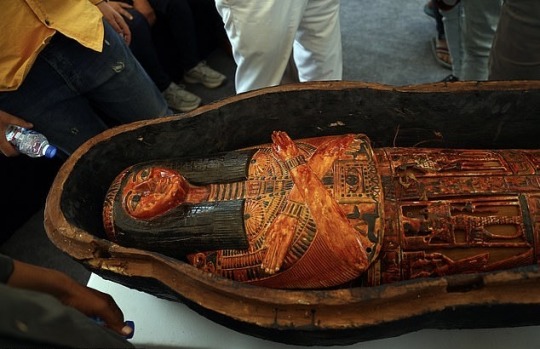

3,400-Year-Old Ancient Egyptian Cemetery Found With Colorful Coffins
Archaeologists have uncovered an Ancient Egyptian cemetery dated to more than 3,000 years ago containing the colorful coffin of a high priest's daughter and preserved mummies, among hundreds of other finds.
Researchers unearthed the cemetery at the Tuna el-Gebel necropolis, located almost 170 miles south of Cairo in Minya Governate, Egypt's Ministry of Tourism and Antiquities announced in a statement on Sunday.
The cemetery, which dates back to the New Kingdom (16th-11th centuries B.C.) of ancient Egypt, was used as a burial ground for senior officials and priests during the period, according to archaeologists.
The cemetery was uncovered during excavations that began last August in the Al-Ghuraifa area of Tuna El-Gebel and features "many tombs" that have been carved into rock.
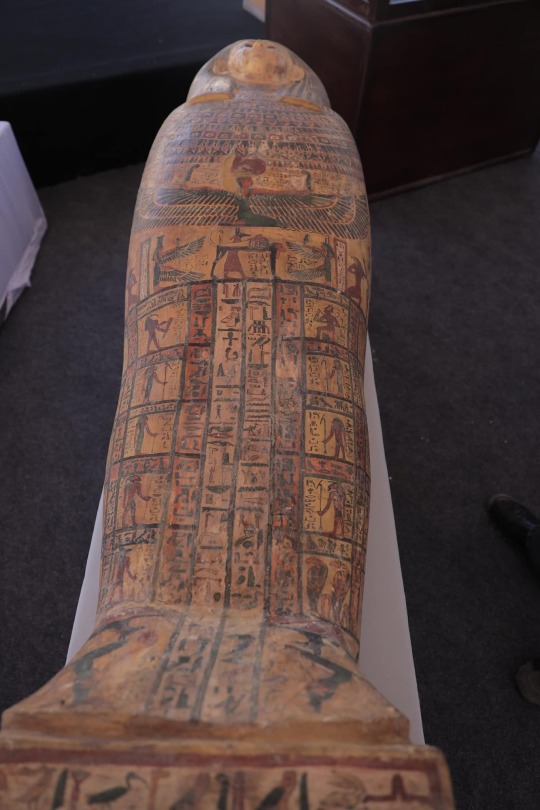
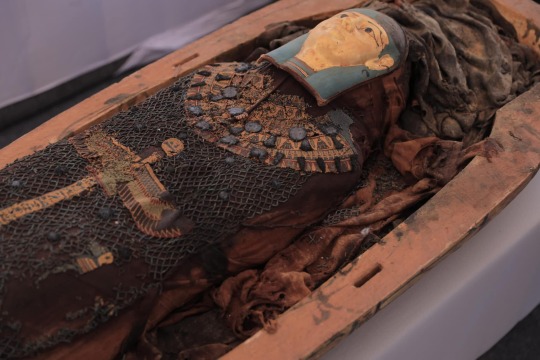
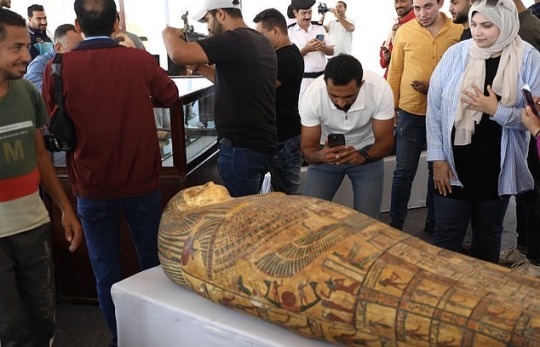
Researchers have also made hundreds of archaeological finds at the site, including stone and wooden coffins—some of which contained mummies—amulets, ornaments and funerary figurines.
One of the most notable finds at the cemetery is a colorful, engraved coffin belonging to the daughter of a high priest of the ancient Egyptian god Djehuti, often referred to as Thoth.
This deity, commonly depicted as a man with the head of an ibis or baboon, was a key figure in ancient Egyptian mythology and played several prominent roles. For example, Thoth was credited with the invention of writing and is also believed to have served as a representative of the sun god Ra.
Next to the coffin of the high priest's daughter, archaeologists found two wooden boxes containing her canopic jars, as well as a complete set of "ushabti" statues.


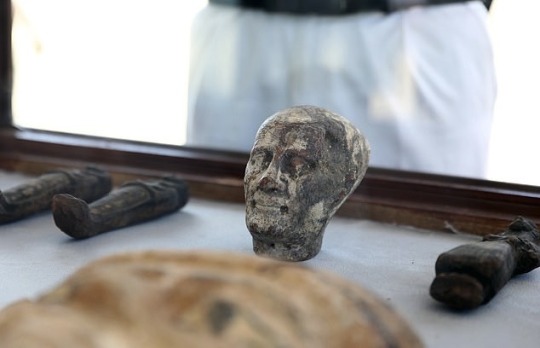
Canopic jars were vessels used by the ancient Egyptians to store the organs removed from the body in the process of mummification—the lungs, liver, intestines and stomach—in order to preserve them for the afterlife.
Ushabti statues, meanwhile, were figurines used in ancient Egyptian funerary practices that were placed in tombs in the belief that they would act as servants for the deceased in the afterlife.
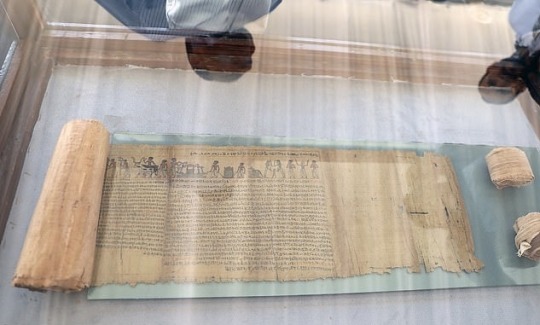

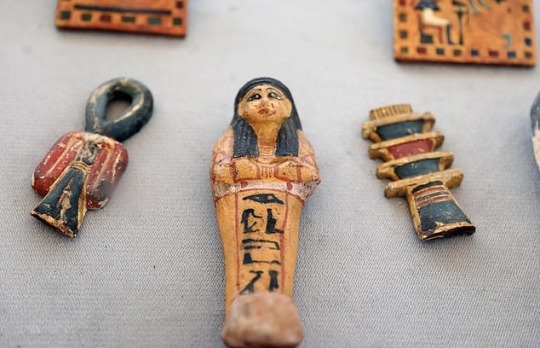

Archaeologists also made another particularly fascinating find at the New Kingdom cemetery: a complete and well-preserved papyrus scroll measuring approximately 42-49 feet in length that features information related to the Book of the Dead.
The Book of the Dead is a collection of ancient Egyptian funerary texts consisting of spells or magic formulas that were placed in tombs. These texts were thought to protect and aid the deceased in the afterlife. They were generally written on papyrus, a material similar to thick paper that was used as a writing surface in ancient times.
Mostafa Waziri, secretary general of the Supreme Council of Antiquities, said in the statement that the discovery of the cemetery is an "important" find.
By Aristos Georgiou.

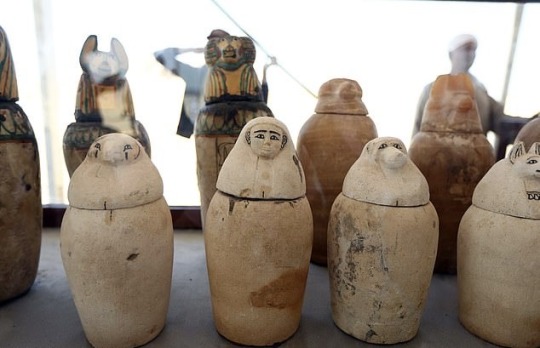
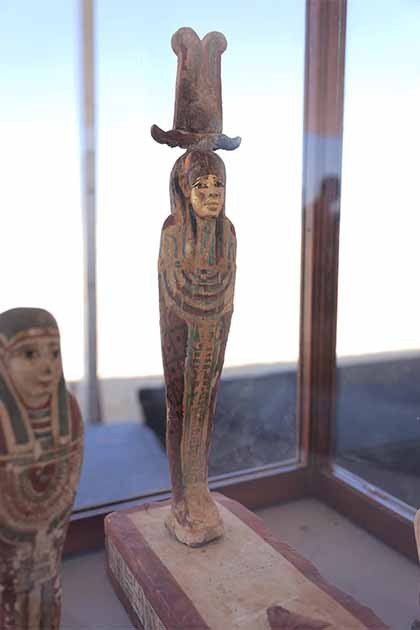

#3400-Year-Old Ancient Egyptian Cemetery Found With Colorful Coffins#Tuna el-Gebel necropolis#Minya Governate#ancient grave#ancient tomb#ancient cemetery#ancient necropolis#book of the dead#canopic jars#Egyptian god Djehuti#high priest#high priestess#ancient artifacts#archeology#archeolgst#history#history news#ancient history#ancient culture#ancient civilizations#ancient egypt#egyptian history#egyptian gods#egyptian mythology#egyptian art
181 notes
·
View notes
Text

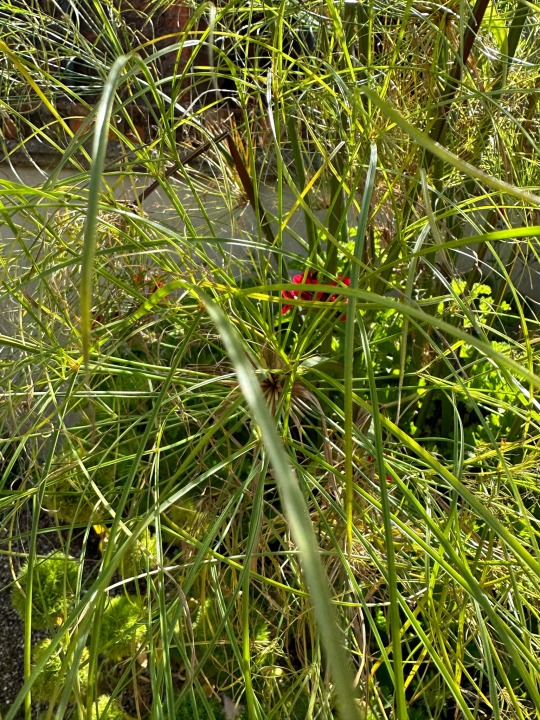





Plant of the Day
Thursday 22 February 2024
As winter ends it is time to start thinking about plants for summer containers. This was a great one I saw last year at RHS Hyde Hall, Essex, including a planting with a central Cyperus papyrus (Egyptian paper rush) surrounded by Dianthus barbatus 'Temarisou’ (sweet william, green trick) and Pelargonium ‘Crimson Unique’.
Jill Raggett
#Cyperus#Egyptian paper rush#dianthus#sweet william#pelargonium#container#containers#plants#horticulture#gardens#essex#rhs Hyde Hall#garden#tender#perennials#green flowers#red flowers
73 notes
·
View notes
Text
Lunch "Dates"
Part Two Here!
A/n: Look at me actually following through with writing. I'm trying to fall back in love with it again but please be patient with me. I am thinking about making this a series or just maybe making it a general universe and having some random one-shots that all kinda connect. Anyway, I hope yall like it. I didn't really edit it all that much tbh... -G
Word Count: 2,032
Pairing: Steven Grant x reader
Warnings: None, just fluff for the most part
Summary: You work as a conservator at the museum Steven works at, regularly sneaking him in on your shared lunch breaks so he can see the artifacts he’s so fond of and occasionally get his help on things (even if you still have to call in a “professional”). But what happens when Steven gets fired and then goes missing? Who’s supposed to accompany you on your lunches? And why do you miss him so damn much?

Life in the conservation lab was never boring. Just as a project seemed to become mundane, you’d find something hidden under the dirt and grime of centuries past that peeked your interest. Either that or you’d finished your current project and it was time to embark on a new one. The collections for the museum had recently received a rather large donation of Egyptian papyrus and you were currently working on cleaning them. While dabbing the delicate plant-based paper with a sponge seemed boring to most you enjoyed the satisfaction of uncovering the secrets found beneath the grime. You’d cleaned off a decent section of the mostly intact papyrus when your watch buzzed, letting you know it was time for lunch. You smiled to yourself as you put things away, leaving the artifact out since you knew you’d be back in a moment anyway.
As you removed and disposed of your gloves you gave a small wave to your co-workers, letting them know you’d be back in a moment. You made your way down the stairs to the main level and stopped in one of the many gift shops the museum had to offer, waiting for a certain gift-shoppist to finish with a customer. When the father and daughter in front of you left you gave Steven a warm smile before leaning onto the counter. “So, you know how we got some new stuff in from Cairo? Well, I’ve been working on a papyrus, and it would be super helpful if I had a translator.”
Steven beamed at you, knowing your whole translator thing was just an excuse to get him down there. He had been teaching you hieroglyphs and you had a specialist at your call when you would need them. “Of course!” He smiled “Let me just clock out for lunch and I’ll be right out, yeah?” You nodded in response and within minutes Steven was following you back up to the lab.
“This whole collection is amazing. A lot of it is in pretty good shape although I will definitely still have to make a lot of repairs. The one I’m working on now is the most intact piece in the collection.” You mused as you buzzed yourself into the lab, signed Steven in, and then made your way to your workstation. “Here she is” you hummed as you gestured to the large section of a scroll in front of you. “Still have to piece some parts together but that’ll be easier when its clean and I can see what I’m working with.” You explained.
Steven carefully leaned down over the papyrus; eyes wide as he took everything in “This is amazing.” He gushed. “I mean the size of the piece-“
“I know!” You interrupted excitedly, “usually we only get fragments from private donors, but this is insane.” As you spoke Steven grabbed a nearby notebook, eager to try and figure out what the uncovered hieroglyphs said. It was a bit choppy since some pieces were missing but he was able to transcribe most of it into your notebook. “I had something else I wanted to show you.” You hummed, watching as he worked. Steven perked up a bit as you grabbed a small box from one of the other tables in the lab and brought it over to him. You opened the box to reveal a shiny golden scarab inside. Steven’s eyes went wide as he looked to the golden artifact, his hand hovering over the box “What is it?” He asked. “We don’t know, but considering the shape it’s in it almost looks like whoever had it went through good measures to keep in nice and hidden away. We found this small box inside a puzzle box inside a lock box.” You explained. “They think it’s some sort of jewelry thing but that really doesn’t make sense because-“ You were cut off by a buzz on your wrist letting you know you only had a few minutes left of lunch. “We should actually eat something huh?” You rubbed the back of your neck sheepishly as you closed the box and put it back in its spot. You and Steven had your usual lunch of sandwiches on the steps of the museum, Steven brainstorming what the scarab could be between bites. The rest of the day went by, and it wasn’t long before you and Steven were saying your goodbyes on the street in front of the museum.
“See you Monday?” You asked as you pulled your keys from your bag, not having that much of a walk to get to your apartment.
Steven nodded, giving you a small wave “Monday.” He confirmed “Laters gators.” He smiled at you as he began to move to his bus stop. You smiled to yourself as you walked the few blocks to your apartment in the other direction.
---
Steven didn’t fully remember getting home that night. He remembered the butterflies in his stomach when you came to visit him, something he thought would’ve gone away by now. He remembered that he had a date the next day with Alex that he didn’t remember asking her out on. He’d liked the tour guide sure, but he liked you more. He shook the thought from his head, just happy that whatever the hell he had just experienced was a dream. Truth be told he was more focused on how Gus seemed to have two fins now rather than the fact that the same scarab you’d shown him had been a pretty big part of his dream. He never really had much time to think about that either, considering the date he was supposed to go on had been a complete and total failure. He almost tried to seek you out, to find some comfort in the madness of the day but he didn’t have your number or any other way to try and reach you. Instead, he settled on eating the chocolates he’d bought in his apartment and sharing the occasional sprinkle with Not Gus.
He was too distracted by the man from his dream not only being real but following him to work to even notice that you were waiting for him at the desk. Too focused on trying to get JP to actually do some semblance of security, to find safety somewhere to notice that you had taken the boxes Donna had practically dumped on him. Too distracted from, running away from the strange ma with the crocodile cane to notice that you had been waiting in the gift shop for him.
“You alright?” Your voice made him nearly jump out of his skin, earning him a worried look from you.
“Yeah, yeah I’m fine.” He gave you a reassuring smile, but it didn’t do much to quell your worries. “Just a long weekend.” He mumbled to himself.
“I heard,” You sighed, and he looked up at you, curious “Alex isn’t exactly happy with you and she’s not being quiet about it.” You fill in the blanks for him before he can ask. “I tried to calm her down a bit, told her you get your days mixed up sometimes. I’m sorry Steven.” You shot him a small smile “I gotta go but I’ll see you at lunch yeah?”
Steven just nodded, watching as you left the gift shop. He sighed to himself and began to put things away and get the register sorted for customers. He just had to make it to lunch. Then maybe he’d have some semblance of normalcy, of safety in your company. He’d told you about his issues with sleeping in the past, with his dreams, explained how he’d lost days sometimes. You’d never judged him, instead doing everything you could to help him out. You knew there wasn’t much you could do but it did help to just know someone cared, that someone was listening. The day seemed to drag on until Steven saw you again for lunch.
“You wouldn’t happen to have seen a golden scarab lying around?” Your words made Steven freeze. He had in his maybe dream, maybe he shouldn’t tell you about it. What if you thought he stole it?
Steven shook his head no and you sighed, figuring it would be the answer. “Jess probably just took it to cleaning and didn’t put it back. I told her she needs to actually fill out her sheets, so we know what she’d working on, but she never listens and now we’re missing an artifact.” You let out a small huff before shaking the negativity from your head. If Steven wasn’t so worried about what the hell happened to the scarab and what he had to do with it he’d think you were cute. Instead, his mind was racing with every possibility and what the hell was going on. He was zoned out for most of lunch, half listening to you talk about your weekend. You didn’t seem to notice and if you did you didn’t bring it up.
---
Steven was off all of Monday, it was easy to tell. You didn’t push him though, hearing enough about his weekend from Alex and knowing he was likely in a bad mood from missing the date. What you didn’t expect was to walk into work on Tuesday to a mess in the bathrooms and Steven and JP going over the security footage. “That’s not me mate” You heard Steven mumble under his breath, moments later he was called to HR. You heard he’d been walked out and that was that. There was no way for you to call him, to email him, hell you would’ve settled for knocking on the man’s door at this point. You knew there was no way in hell sweet little Steven would’ve been able to rip apart the bathroom the way it had been. It looked like the Hulk had gone through there, not Steven, Steven who wouldn’t hurt a fly let alone a whole bathroom. He’d left before your lunch, so you hadn’t known for sure till you saw Donna in the gift shop. The rest of the week dragged by with you hoping everyday that you’d see a familiar curly haired man in the gift shop, but he didn’t come back. Donna had made it pretty clear to you that if she had anything to say about it, he never would.
As the days passed on you realize just how much you had cared for Steven, just how much light he had brought to your workday. You missed your little lunch dates, your conversations about whatever was in the lab that day. You missed finding excuses to have him come up to the lab and show him what you’d been working on, not knowing many other people who had appreciated your work. You missed having a friend around. About a month had passed since Steven had been fired. You were walking up the stairs to work when you heard someone call out your name. You didn’t recognize the voice at first but as you looked around you spotted Steven at the bottom of the steps. You smiled wide and practically ran down them to meet him.
“Steven?” You smiled up at him, wrapping your arms around him “Where the hell have you been?”
The man stayed silent although his arms found their way around you. “Long story love, very long story.” He chuckled a bit.
You pulled back and took him in, your heart racing slightly as you debated on if you should ask him to tell you about it over dinner, but he beat you to the punch.
“Why don’t I meet you here after your shift? You’re still off at five, right?” Steven asked and you answered with a nod. “Great. It’s a date.”
You bid him goodbye quickly making your way back inside in hopes that he wouldn’t see just how excited the prospect of a date with him made you. You could’ve sworn you heard Steven mutter a curse under his breath, but you figured you could ask about it later on your date. Your date with Steven. You practically skipped to the lab, eager for the day to end.
#steven grant x you#steven grant x reader#steven grant#moon knight fanfic#moon knight fluff#marc spector x reader#marc spector#moon knight system#moon knight system x reader
188 notes
·
View notes
Text
Ancient Egypt and Ostrich Feathers
Have a question for the Egyptologists and knowledgeable fans of Ancient Egypt about ostrich feathers.
(btw is there an Egyptologist Tumblr community? I follow @thatlittleegyptologist but don't know of any other accounts. HMU!)
When I was in Egypt last month I went to the Grand Egyptian Museum to take the very limited tour of the atrium they offer now. It... wasn't worth the money. Anywho, our tour guide did his best to make it seem valuable by talking a LOT about each thing he showed us.
Next to the colossal statue of Ramses II that dominates the atrium there's a table showing the emblems of royal iconography. The sun disk, the nemes headdress, cow horns, and a feather. He asks us if we know what that last one is and I or someone says it's the feather of Ma'at. Correct! Do we know what bird it comes from? The ostrich, someone else says. Why did they choose ostrich feathers for Ma'at and also certain crowns?
On this trip I had gone to the Nubian museum and thus had just seen several pieces of art from pre-historical peoples that utilized ostrich eggs, including a famous one that had three pyramids etched into it along with some animals. So I said something like: The ostrich has been an important animal even before the pharaohs. They relied on it for food and made art with the eggs. The tour guide (Mark) said: That's an awfully materialistic view. No, that's not why.
Now... I know I'm not an expert even though I know a lot about ancient Egypt. But "a materialistic view"? Like somehow it's not enough that ostriches provided food and probably were used in other, important ways? Why do you think Hathor is represented as a cow and there are cow horns incorporated in crowns? Because they look cool? wtf?
Mark then goes on to tell this story. Back in the dawn of civilization in Egypt the Egyptian man didn't have much to do during the day. (eyebrow raise) So he started collecting feathers from all the birds that flew above him in the sky. (...um... wait...) He would collect and then count the barbules and do you know what he discovered? Only the ostrich had the same number of them on both sides. That's why this is the feather of balance and justice.
Friends. I have never wanted to scream SHENANIGANS or at least CITE YOUR SOURCES so much in my life. Like... what?
Leaving aside the implication that ostriches were somehow flying above ancient Egyptians or that there was some point where men didn't have a dang thing to do all day but count the little hairs on feathers, I feel like this explanation is complete hooey. I mean, it could be that all or some of an ostrich's feathers have the same amount of barbules on either side of the middle bit. You might even be able to convince me that this isn't true for any other bird that someone from the Nile valley 6,000+ years ago had access to. But I'm going to need a ton of supporting evidence that this is the sole reason why the feather of Ma'at is an ostrich feather and not for the "materialistic" reasons I cited.
Also, I'm sorry, but I'm real sure predynastic Nile valley dwellers were far more concerned about food and shelter than coming up with complex reasons for using a certain kind of feather to represent a metaphysical thing.
However, I could be wrong! So I'm asking: is there evidence for Mark's version of events? Is this, you know, written somewhere in a papyrus or on a temple wall or another place? I would honestly love to read any papers on this subject, whatever the background on it.
As to the Grand Egyptian Museum, I really hope that whoever they hire to give tours when the whole thing opens are better at this than Mark. I wasn't impressed with his tour overall and eventually gave up listening to him once I saw that there was a gelato place open for business inside.
#Egyptology#Egyptologists#Calling for Egyptologists!#Egypt#Ancient Egypt#I need to know if Mark is right#okay kay what I really want to know is that mark is wrong
322 notes
·
View notes
Text
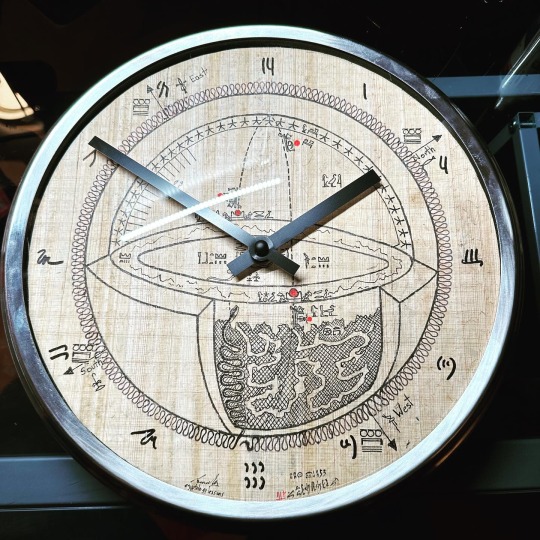

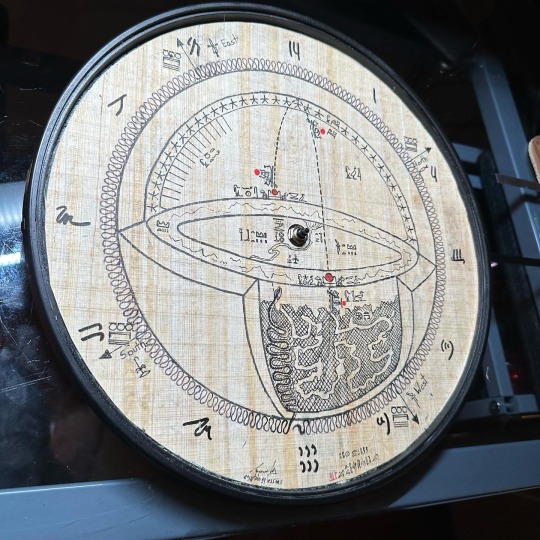





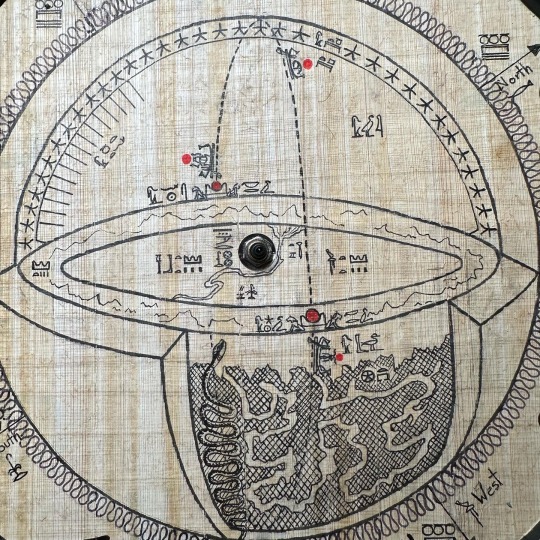

A modern recreation of the Ancient Egyptian cosmological world. The video provides details and explanation of the art, which is greated on natural papyrus paper.
Dimensions: Diameter 12”, Depth of Clock 2”
The original concept art derived from Egyptologist @Tito Vivas (Gracias/Thank you)
Photo of Tito shared by Egyptologist @elianubis (Gracias/Thank you)
𓋹𓎬𓋹𓎬𓋹𓎬𓋹𓎬𓋹𓎬𓋹𓎬𓋹𓎬𓋹𓎬𓋹𓎬𓋹𓎬𓋹𓎬𓋹𓎬𓋹𓎬𓋹𓎬𓋹𓎬𓋹
🎥 @egyptologylessons 𓋹𓊽𓋴𓆖𓎛𓇳𓎛 ©️ 𓊁𓊁𓊁𓊁𓊁𓊁𓊁𓊁𓊁𓊁𓊁𓊁𓊁𓊁𓊁𓊁𓊁
#Ancientegypt #ägypten #egyptology #egypte #egitto #egipto #이집트 #egypt #egyptologylessons #cosmology #mythology #hieroglyphs #hieratic #clock #egypte
#ancientegypt#egyptology#egypte#hieroglyphics#egyptologist#hieroglyphs#clock#cosmology#Ancient Egyptian#Ancient Egypt
24 notes
·
View notes
Note
okay, here is a fun little question for you: of all the celebrations and ceremonies and festivals and parties held across ancient egypt, which do you think would be the most lit and why?
To be fair we don't know a lot about most of them, only that they happened. They didn't really write this sort of thing down in any detail unless it was a major festival. The little ones held locally, we only really know the names of unfortunately.
I guess the 'most lit' would be Heb Tekh (The Festival of Drunkenness) and I'm going to copy what I said from another ask ages ago to explain what this festival was, and then you can see why I chose it.
Heb Tekh, or the Festival of Drunkenness, and also the Beautiful Feast of the Valley are the ones that a lot of people cite as the ones everyone knows when it comes to the drunken sex festivals. It’s the one with the ‘drunken orgies’ in honour of the goddess Bastet (or Hathor or Sekhmet, it depends because they can be interchangeable in the myth this references). This is a celebration of the myth of the Destruction of Mankind, wherein Hathor/Sekhmet/Bastet is sent to kill mankind by Re, but he changes his mind and they have to subdue her bloodlust with beer coloured red with ochre. She gets drunk, and mankind is saved. The festival uses beer and sexual acts, to give thanks and ask for a good inundation. It’s important to note here that it’s not ‘sex for fun’ but rather ‘sex as part of a religious ritual’, so when thinking about it you need to detach the part of you that thinks ‘ew sex in religion’ and come into it with a much more neutral ‘this is what the Egyptians believed’.
Using this article here by Victorian Jensen (Berkeley), the earliest, and non contestable, evidence for the Heb Tekh is a 12th Dynasty papyrus from the Pyramid town of Lahun which records a festival of drunkenness on that date, and then in the 18th Dynasty at the Temple of Mut at Karnak, Hatshepsut built a ‘porch of drunkenness’ for the festival that’s the same date as the 12th Dynasty festival. As the festival if in the ‘flood’ (Akhet) season, it’s associated with fertility too. Basically, they would feast until they got drunk and fell asleep in the temple courtyard, or the feast would take place in the home with the same results. One of my former lecturers is part of the dig team for the Temple/Precinct of Mut, and when they taught us about this festival, they mentioned the drunken sex that was a result of this festival, and that it usually occurred in tombs of dead relatives as it was supposed to increase fertility and luck. This is also key since it takes place during Akhet, and graffiti has been found that discusses ‘travelling to the marshes’ during the festival, which is an Egyptian euphemism for sex, as they viewed marshes as the place from where life sprang forth, equating them with the Primordial mound. Here, I’m referencing this 2014 work (from a 2010 conference paper) by Betsy Bryan(John Hopkins), and if people don’t want to read a long article (you do have to scroll through the entire bibliography before you get to it), then you can read this 2013 LA Times article with Betsy Bryan herself. I quote from the first article:
A hall of drunkenness (wꜢḫ/wḫꜢ n tḫ) is not so far otherwise attested, although a st tḫ is identified in the Medamud hymn concerning the festival of drunkenness discussed by J. Darnell (1995, pp. 49–59). Darnell has commented that “places of drinking” should be understood as kiosks along the river bank akin to those beer kiosks referred to in love songs. He likened them to the mswr referred to in drinking songs from the Processional Colonnade’s Opet Festival reliefs at Luxor temple (ibid., p. 59 nn. 66–67; Epigraphic Survey 1994,pp. 12–14, pls. 26, 97). However, the st (n) tḫ in the Medamud hymn is a parallel term for the hall of traversing the marshes associated with temple courts with papyriform columns emulating the fertile aquatic place of creation: mἰ.ṯ swtwt m st tḫ wꜢḫy pfy n sꜢb sšw “Come the procession is in the place of drunkenness, that hall of traversing the marshes” (Darnell 1995, pp. 50–52; DePauw and Smith 2004, pp. 82, 88–89)….
….It is likely, how-ever, that the court before the temple, bounded by the mudbrick Second Pylon and east and west enclosing walls, housed the sequences of the festivals that began earlier in the evening, including the procession of participants, lighting lamps, prodigious drinking, and sexual behavior as described for the goddess Rattawy in the Medamud hymn, the demotic ostraca published by DePauw and Smith, and the Mut hymn recently published by Jasnow and Smith (Darnell 1995, DePauw and Smith 2004, Jasnow and Smith 2010–11).
We’re not entirely sure about why they included sex in this festival, since it does not occur in the original myth. However, knowing at what time it takes place (during the rising fertile flood waters), the repeated references to the fertility aspect of the goddesses, and songs about the festival that sing:
“I remember visiting the ancestors, and when I went, anointed with perfume as a mistress of drunkenness, traveling the marshes.”
When a tomb is a place of rebirth, and taking place during the fertile season, for a festival of a fertility goddess, it would seem likely that the drunkenness and sexual content of the festival was on the one hand to replicate the subdued nature of the drunken goddess, and on the other to placate her with fertility rituals in order to ask for fertile soil and a good crop of food. Early references to sexual behaviour during the festival tend to take the form of euphemisms, like the one above, whereas later periods, like the Ptolemaic and Roman, are much more open about what was occurring (page 118 of Bryan’s article is where the proper discussion on sexual activity takes place).
So, Heb Tekh is lit because it involves getting drunk and fucking in temples or the tombs of your ancestors in the name of religion.
62 notes
·
View notes
Photo


“The ancient Egyptians used the stem of the papyrus plant to make sails, cloth, mats, cords, and, above all, paper. Paper made from papyrus was the chief writing material in ancient Egypt, was adopted by the Greeks, and was used extensively in the Roman Empire.” (source)
117 notes
·
View notes
Text
"The Winged Isis Papyrus: A Majestic Depiction of the Divine Goddess
The Winged Isis papyrus is a depiction of the goddess Isis, a prominent deity in ancient Egyptian religion, with her wings outstretched. The papyrus is a work of art that was created in ancient Egypt, likely during the Late Period (664-332 BCE) or Ptolemaic Period (332-30 BCE).
The image of Isis on the papyrus is typically depicted as a woman with the horns of a cow and a solar disk on her head, symbolizing her role as a mother goddess and her connection to the sun. She is shown wearing a long dress and carrying a lotus flower in one hand and a papyrus scepter in the other.
#egyptian papyrus paper#pharaonic papyrus paper art#phaoaonic papyrus museum#pharaonic papyrus gallry#pharaonic papyrus r sphinx square#winged isis#golden mask#king tutankhamun.#clivk ti get winged isis:#https://payhip.com/EgyptianPharaonic
0 notes
Note
I have a question for you. I'm doing research on historical pregnancy tests, and the pissing on barley test was mentioned for Egypt. Is this correct? Which papyri is this found in? Thank you!
Yes! There are a few papyri that contain/mention pregnancy tests, actually. One of them is Pap. Carlsberg 8, but that one is very lacunose, another is the Berlin Medical Papyrus.
Here’s the excerpt from that one, also known as Papyrus Berlin 3038, as translated by Dawson:
Another test for a woman who will bear or a woman who will not bear. Wheat and spelt: let the woman water them daily with her urine like dates and like sh'at seeds in two bags. If they both grow, she will bear: if the wheat grows, it will be a boy; if the spelt grows, it will be a girl. If neither grows, she will not bear.
The test is a general pregnancy test and in some cases like the above, also a gender-prediction test. The hopefully-pregnant woman is supposed to urinate on bags of two different grains, and if both or either sprouted, the woman was pregnant. The gender of the child was thought to be indicated by the type of grain that sprouted faster than the other. If neither grain sprouted, the woman was supposedly not pregnant.
Now the interpretations of how the grains mentioned in the papyrus should be translated differ. In the excerpt above, Dawson mentions wheat and spelt. Other versions translate the terms as emmer (girl) and barley (boy). The 10th century text Kamel-el-Sinaafil Tibb includes what seems to be a variant of this test, which mentions barley, wheat (and beans). This text doesn’t mention anything about gender-prediction, however.
There have been a few different studies on the efficacy of this test. In 1963, Paul Ghalioungui spearheaded the first one. The grains chosen for this study were wheat and barley. You can read the paper about this study here; but to make an interesting story short: in 23 of 40 cases involving pregnant urine the grain sprouted in a way that approximated control, and in another 5 of those 40 cases the growth was poorer than control, but definitely there. In 12 cases there was no growth. In 23 cases one grain grew faster than the other: in 7 cases the prediction of gender as suggested by the papyrus was correct; in the other 16 it was incorrect. There was a 100% failure to grow in the grains watered with the urine of non-pregnant individuals, both male and female.
The study does mention that they kept the seeds on filter paper and not in a mixture of sand and dates, as the Egyptian test mentions is necessary. There is also still the possibility that the wheat and barley are not the correct types of grain. So this should be taken into consideration while discussing the results of this study, although these are still seriously interesting! One of the conclusions is that it’s possible that the hormones estrogen and progesterone, present in high quantities in pregnant women, help in germination of the grains.
#still mad I was nauseous for 22 weeks straight when i was finally pregnant and couldn't piss on anything without also needing to throw up#egyptology#ancient egypt#ancient egyptian medicine#pregnancy test#you activated my trap card so you get more than you asked for
85 notes
·
View notes
Text
Simple facts about Ancient Egypt (2)
Last time, we talked about generalities - history, geography, pharaohs, government... Today, let’s look at some of the main social classes and jobs in Ancient Egypt!
As I said before - warning, these are oversimplified and general facts for a short and easy introduction and comprehension to Ancient Egypt. These are not in-depths studies or analysis, and I might have gotten things wrong, so beware!
SCRIBES
# Scribes, from the Latin “scribere” (to write) were public writers: they were tasked with redacting administrative documents, with the job of accountants of the State, but they were also tasked with writing things such as letters, poems or fictional tales. The job of a scribe went from father to son, and every future scribe had to undergo a very strict and difficult apprenticeship. To be a scribe was a very envied position, for it was a privilege given only to boys – and to the wealthiest of boys! The material of the scribe was quite simple, all contained in a wooden case: there was just a reed pen, and two blocks of ink, one red and one black – to write, the scribe plunged the tip of his reed pen into water, and then rubbed it against either the black or red ink-block.
# Because ink was we know it today didn’t exist back then in Egypt – their “ink” was actually blocks of compact powder. Black ink was created with soot or crushed coal, whereas red ink was created with ochre. Similarly, the Ancient Egyptians did not write on paper but on papyrus – a type of material that shared its name with the type of Nile-reed it was created from. (Fun fact, the name “paper” does come from “papyrus”). Creating papyrus was done by cutting and peeling the papyrus-reed into thin slices, that were then gorged with water, placed in crosses layered on top of each other, and then brutally hit with a hammer until it became one uniformed page (the sap of the reed and the water fused together to form a sort of “glue” holding the stripes together). Finally, the page was thinned down, and smoothed with wooden items.
# Papyrus was however very costly. So, to not lose all of one’s money, Ancient Egyptians wrote for every day needs on pottery fragments or wooden planks covered in plaster. Pupils in schools for example wrote on broken pieces of bowls or vases. The papyrus, so precious, was kept exclusively for law texts and religious texts. To create 5 scrolls of papyrus, of roughly 10 meters each, a man had to work for a whole year!
# Most scribes worked for the government: one of their job was to do note down the state and quantity of the harvests each year before calculating the taxes based on the amount of harvest. They were also the accountants of the state, as well as the ones charged with writing down the laws and the orders of ministers. Other scribes rather worked for temples, where they engraved magical incantations on amulets ; and a third group acted as clerks in tribunals.
# Learning to become a scribe might look easy, since what you need to do was just copy texts all day long… But in truth it was a very hard thing! Our alphabet only has two dozen letters or so – the Egyptian scribes had to learn thousands of different signs to write down the texts, and they had to learn how to write them on every material possible. If you wanted to be a scribe, you had to go a “scribe school” – pupils usually went there are the age of ten, and left at fifteen. After these five years of studies, the scribes had to undergo an internship of five years in either the administration, in a temple or with a notary. After this internship, would-be-scribes had a final exam – and it was only then they could become certified and testified scribes, at twenty years old. Scribe school was notably a very harsh and unpleasant place – a common saying among scribe teachers was “Students have ears in the back, and these ears only listen when you hit them”. Yes, corporal punishment was a standard method of teaching in these schools – if students didn’t pay attention, spoke with each other instead of copying their texts, or wrote a hieroglyph wrong, they were immediately beaten up with a stick. In fact, to prevent the students of scribe schools from leaving unsupervised, the teachers attached to their ankles wooden blocks! Yes, just like the cartoon prisoner with the iron ball around their ankle!
# All scientists were scribes, but not all scribes were scientists (or scholars). You see, to become a scientist or a scholar you had to learn how to write and read – and to do that, you needed to become a scribe. But many scribes stopped there and did not pursue their studies further – only some decided to take on a specific field of expertise (medicine, architecture, astronomy) and thus became more than just “regular” scribes.
# Scribes wrote their text in a very specific way. They sat cross-legged on the ground, placed the papyrus they wrote on their loincloth – that was pushed by their knee very strongly on each side, so it would be a flat surface to write onto. Scribes also wrote with their pen standing up, very still – so that they wouldn’t do any stain or mess up a line, because their ink took a very long time to dry.
# Scribes were the object of admiration, but also jealousy, from the everyday ordinary Egyptian man, because scribes were very well paid AND were exempt of taxes. Plus, their work was a non-manual one, unlike the other Egyptian men who were peasants or craftsmen. This was notably why in Egyptian art scribes are always depicted with a potbelly or fat rolls – thanks to their wealth and effortless job that demanded them to sit around all day, they were the only inhabitants of Ancient Egypt who could easily become fat. In return, the scribes themselves were very proud of their position and status – and this often made them quite arrogant, according to the ancient texts. One of the favorite entertainments of the scribes was to mock other jobs or workforces of Egypt by telling funny stories or jokes about them.
PRIESTS
# Do not get things wrong: in Egyptian religion, only the pharaoh can act as an intermediary between the gods and men – he is the true voice and right hand of the gods. But then, you’ll ask, why are there priests? Well it is simply because the pharaoh is one human man, and cannot be everywhere in the country – so the pharaoh delegates his powers to the priests, who act in his name. This is something important to remember: Ancient Egypt was a form of theocracy, and the priests did not get their power from the gods but from the pharaoh. Though the priests’ role WAS to serve the gods. Ancient Egyptians and Ancient Egyptian gods had a deal worked out: the priests would tend to their need, and take care of them, through various festive celebrations and everyday rituals, and in exchanged from being tended to, the gods ensured the protection and wellness of the city/region/country they were worshiped in. As easy as that. But this explains why for example priests were not depicted on murals or paintings of temples: priests were not perceived as worthy of being depicted alongside the gods, because in the Egyptian mindset, priests are just servants – or rather some sort of religious bureaucrats. Only the pharaoh, the one and true emissary of the god, and himself equal to the gods, could be painted on the walls of temples.
# The role of priests, just like the one of scribe, usually was passed from father to son. Usually priests began their apprenticeship as children, studying at the school and at the library of the temple alongside scribes. Given being a priest was a very prestigious function (again, quite like scribes), some people rather could buy a priest job with a heavy sum of money, or it could be given by the pharaoh himself as a reward, to those that served him well and faithfully.
# In every great temple and religious center of Egypt there was, at the top of the priestly hierarchy, a great priest, or “first prophet”, named directly and personally by the pharaoh. This great priest held authority over all of the other priests, and also played a political role in the city he was in charge of. Below him came the “divine fathers”, important priests that took care of the rituals and walked in front of their god’s statue during processions. Finally, at the bottom of the hierarchy, there were the “purified ones”, whose job was to carry the god’s statue during procession, to clean up the temple every day, and to do all the chores. Speaking of cleanliness, being pure was a very big deal for Ancient Egyptian priests – they usually took four baths a day in the lake’s temple, or rather two baths during the day and two baths during the night. It was a way for them to stay “pure”.
# Priests had a LOT of work and so, to be able to rest and not die of exhaustion, there were “teams” of priests formed in temples. Each team was to work in the temple during one month while the other went to live into town, and after one month a new team went in. In smallest temple there were only two teams, each doing half of the year, but in the biggest temple, there could be up to four priest teams. And since the priests were to live in the town quite regularly, and couldn’t possibly live alone (for Egyptians a man couldn’t just live all on his own, it was not a good or healthy lifestyle), the priests were allowed and even encouraged to marry, so that when leaving the temple they could have a wife and children to return to – children that in turn would become priests once their father grew too old.
PEASANTS
# Peasants formed the bulk of the Egyptian population, and they were a key part in the wealth of the nation: without them and their constant toil, Egypt couldn’t have existed. But despite their immense utility, priests were very poor and not respected, forming the lower rank of the social hierarchy. Most of them acted like serfs, in service of great landowners, temples, or the ministers of the pharaoh. The comparison to serfs is quite relevant as, just like serfs, Egyptian peasants did not own their lands, and they could be sold just alongside the land they were dependent.
# The fields of the peasants were actually really small, roughly the size of a vegetable garden today. They were delimited by big and heavy rocks – every year, bureaucrats of the realm checked after each flood is these rocks hadn’t been move. The peasants also had to swear an oath to never move secretly the stones to augment their field – if they were caught doing that and lying about it, they had their two ears cut off!
# Scribes went three times a year into every peasant’s home. A first time to measure their field, a second time once the cereals ha d grown – to evaluate the harvest and calculate future taxes based on this hypothetical harvest – and a third time during the harvesting, to collect the taxes. Of course, on this third visit, scribes were escorted by armed soldiers. If a peasant refused to pay the taxes, he was beaten up, and/or his house and tools were taken away from him – sometimes he was even thrown into prison. According to some tales, the most extreme cases of punishment had peasants that did not pay their taxes being beaten up, tied with a rope, and thrown at the bottom of a well in front of his wife and children – who in turn were imprisoned in his place! Better pay the taxes the, you say? Well, the problem was that the taxes were calculated during January, two to three months before the actual harvest. If any sort of disaster happened, and they lost their harvest, they still had to pay the taxes as if they had a full harvest…
# No need to tell you that the peasants’ worst enemy (outside of the locust) was the hippopotamus! Hippopotami were considered a true disaster, since in a single night, a hungry hippo could eat up to sixty kilos of plants (132 pounds). If a small group of hippos came by a field in the night, in the morning nothing was left… So peasants hunted and killed hippos without pity or mercy.
CRAFTSMEN
# Craftsmen were the middle-class of Egypt, coming below the scribes and bureaucrats, but above peasants. Craftsmen worked numerous types of material: stone, wood, iron, precious metals (such as gold), leather, textiles and glass. Craftsmen never worked alone – they were always forming groups and teams, part of workshops financed by the government, or by a temple, or by a rich family. Each workshop gathered various specialists – a carpenter, a painter, a smith, a jeweler, a stone-sculptor…
# The quality of a furniture could be identified by the type of wood used: good quality furniture was done by sculpting cedar, a tree that was important from the Lebanon. High quality furniture was also often decorated with ivory or ebony. Lower quality furniture however, was usually sculpted in sycamore trees or palm trees – a wood so friable they were often covered in plaster to just be able to stand up and hold any kind of weight!
# The Egyptians discovered how to make class towards 1500 BCE. They created it with sand, salt, and they always colored their glass with metallic pigments – an Egyptian would have never created a transparent piece of glass. Egyptians loved colors, and so their glass work was always red, blue or yellow.
# Potters were considered to be “different” from other craftsmen. More specifically they were thought to practice a very “common” craft. Scribes liked to mock them by describing them as dirty, and always covered in mud. Potters did not work in the royally-sponsored workshops I described above – they rather worked all alone, for their own. They built most of everyday objects: vases, plates, cups, jars… Potters usually worked with the clay of the Nile, sculpted by hand (at first, then the potter’s wheel was invented), and then left to dry up in the sun before being “cooked” in an oven. Their other technique was to create a material by mixing sand with water, salt, ashes and lime – this substance was then placed inside molds, and placed in an ove.
# Pearls in Ancient Egypt are a fascinating thing, because Egyptians did not know about the existence of oysters – or if they did, they couldn’t access any of them. So, Egyptians created their own pearls, by polishing stones so much they were reduced to very small spheres, that were then pierced to be placed onto necklaces.
# All the gems and precious stones used by Egyptians (the red carnelian, the purple amethyst, the turquoise and the blue agate – plus gold of course) were extracted from mines located in the desert, and in which criminals and law-breakers were sent to work (because working in these mines often killed the miners). The favorite gem of the Egyptians, the lapis-lazuli, was rather important from where today’s Afghanistan is located. However, faience/earthenware was very common among Egyptians precisely because with its blue-green color it could look like emeralds or turquoises, while being much MUCH less costly. This is why there were a lot of faience jewels in Ancient Egypt – they were basically for those who wanted to look good without having the means to.
#ancient egypt#scribes#peasants#egyptian religion#egyptian priests#ancient egyptian crafts#craftsmen#ancient egyptian society
17 notes
·
View notes
Text
Personal Kemetic Magic
Spellwork is a large part of my practice. I wanted to share some of the things that I do for my spells to make them a little bit more Kemetic in nature. My spells are a religious affair as Kemetic magic and religion are not separate. In order to have either I need to have both, but this is my personal gnosis.
I am going to be writing different lists as time goes on, but I have some processes, some spells, and some things that I use below!
My information on how to do spellwork mostly comes from Magic in Ancient Egypt by Geraldine Pinch and The Mechanics of Ancient Egyptian Magical Practice by Robert Kriech Ritner.
Spittle - for Creation
I use spit in practically every spell I do. I know it's a little gross, but I think it really helps seal the spell. Spittle has associations with Atum, and thus creation. In some versions of the myth, Atum's spittle creates the Divine couple Shu and Tefnut, who then give birth to the world. Atum creates only from himself. When using spittle in my spellwork, I liken myself to Atum, and then my spell is charged and created to give me it's desired intent.
There are also baneful ways to use spittle but I usually use it for Creation rather than destruction.
Paper - a method of spellwork
Ancient Egyptian magicians used papyrus often for spells. We know of them using strips of papyrus with a magical spell to wrap around a specific part of the body to help heal that area. They also used papyrus rolls as short-term amulets and writing on amulets of varying shapes as spells for healing or protection. The written word has magical properties. I like to use this kind of magic because it's applicable to the world that I live in. I work with Tehuti often when I do this form of magic, likening my pen, paper, and words, to the pen, paper, and words which Tehuti writes. Sometimes I simply write prayers for the spell. Sometimes it's instructions on how the spell should behave, especially if it's a more long-term spell. It varies because I don't have a set thing that I write since every spell is different.
Your creativity is the limit for paper. I like to keep bowls of prayer to add bunches of paper spells to. I like to burn my paper spells like a bayleaf. Sometimes I like to write on edible things with edible things and then consume it. I write written spells for sleep and dreams and put them under my pillow. There's a spell in Ritner's work where you write and burn the paper. After you burn it, you pour the ashes in cool water and drink it. I'm not saying that you should necessarily do that (trust me it's absolutely horrid) but there are lots of ways that you can use paper!
Destruction - baneful magic
There are lots of instances of Ancient Egyptians using destruction as a way to get rid of things. There's spells to ward of all kinds of psychic attacks, attacks from angry deceased, from Wesir's creatures, from disease, from injury, etc.. King Tutankhamun had sandals with enemies on the bottom of them so he would always be stomping on them. There are a lot of spells to get rid of one's enemy. One spell in Geraldine Pinch's book outline how to get rid of enemies by creating a meatloaf shaped like a penis. After you shape the meat and cook it, you surround it with bread and cook it. Then, you feed the penis to a cat. A roundabout way to destroy, but still a means of creating an enemy up just so you can tear it down. True baneful magic here. You can do this to release energy you don't want, to banish spirits, and most importantly, to help in slaying Apep. Often when I do this kind of work, I align myself with Ma'at, Sekhmet, and Set, who I see as fierce protectors of Ra.
#personal practice#kemetic#kemetic magic#heka#three things i do in my practice#creation#paper spells#spellwork
34 notes
·
View notes
Text
Current WIP (Untitled at the moment)
Steven Grant x Reader (Maybe Marc Spector x Reader later???)
You work as a conservator at the museum Steven works at, regularly sneaking him in on your shared lunch breaks so he can see the artifacts he’s so fond of and occasionally get his help on things (even if you still have to call in a “professional”). But what happens when Steven gets fired and then goes missing? Who’s supposed to accompany you on your lunches? And why do you miss him so damn much?

Life in the conservation lab was never boring. Just as a project seemed to become mundane you’d find something hidden under the dirt and grime of centuries past that piqued your interest. Either that or you’d finished your current project and it was time to embark on a new one. The collections for the museum had recently received a rather large donation of Egyptian papyrus and you were currently working on cleaning them. While dabbing the delicate plant-based paper with a sponge seemed boring to most you enjoyed the satisfaction of uncovering the secrets found beneath the grime. You’d cleaned off a decent section of the mostly intact papyrus when your watch buzzed, letting you know it was time for lunch. You smiled to yourself as you put things away, leaving the artifact out since you knew you’d be back in a moment anyway.
As you removed and disposed of your gloves you gave a small wave to your co-workers, letting them know you’d be back in a moment. You made your way down the stairs to the main level and stopped in one of the many gift shops the museum had to offer, waiting for a certain gift-shoppist to finish with a customer. When the father and daughter in front of you left you gave Steven a warm smile before leaning onto the counter. “So you know how we got some new stuff in from Cairo? Well, I’ve been working on a papyrus and it would be super helpful if I had a translator.”
Steven beamed at you, knowing you’re whole translator thing was just an excuse to get him down there. He had been teaching you hieroglyphs and you had a specialist at your call when you would need them. “Of course!” He smiled “Let me just clock out for lunch and I’ll be right out, yeah?” You nodded in response and within minutes Steven was following you back up to the lab.
“This whole collection is amazing. A lot of it is in pretty good shape although I will definitely still have to make a lot of repairs. The one I’m working on now is the most intact piece in the collection.” You mused as you buzzed yourself into the lab, signed Steven in, and then made your way to your workstation. “Here she is” you hummed as you gestured to the large section of a scroll in front of you. “Still have to piece some parts together but that’ll be easier when it's clean and I can see what I’m working with.” You explained
Steven carefully leaned down over the papyrus, eyes wide as he took everything in “This is amazing.” He gushed. “I mean the size of the piece-“ “I know!” You interrupted excitedly, “Usually we only get fragments from private donors but this is insane.” Steven grabbed a nearby notebook as you spoke, eager to figure out what the uncovered hieroglyphs said. It was a bit choppy since some pieces were missing but he was able to transcribe most of it into your notebook. “I had something else I wanted to show you.”
Read the full fic here
and Part Two here
#Steven x reader#Steven grant x reader#Moon knight x reader#Moon knight fanfic#Steven Grant Fanfic#marvel fanfiction#marvel reader insert#Steven Grant reader insert#Steven Grant Fluff#steven grant x you
23 notes
·
View notes
Text
New Friend for Melina
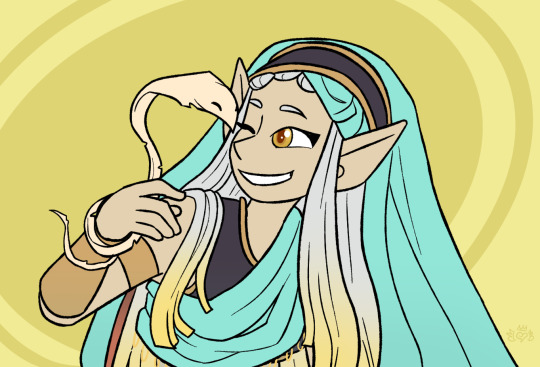
During one of the sessions while Melina was still recovering. She and her party friends fought a group of bandits. When she opened a book she found on one of them what does she find? A cute little paper snake! Also known as a Book Wurm from the cool @the-fluffy-folio
She now has her own little familiar. And she named him Papyrus! Aside from the skeleton reference, it’s a reference to the first paper the Egyptians made. And well you can probably guess the rest. Now she has a paper noodle buddy.
——————————————————————————————————
art by @xjunjox
13 notes
·
View notes